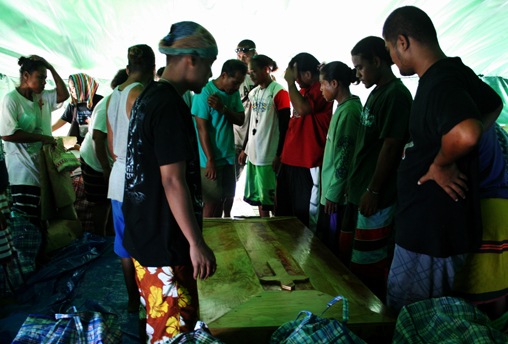The rumble of a ship’s engine is pierced by a human wail. A topless woman in a skirt woven from hibiscus fiber crawls across a deck strewn with baggage and begins weeping over a simple wood coffin that has been wrapped in a blue tarp and decorated with flowery wreaths.

Atoll inhabitants come to main Yap for temporary work or treatment at the hospital but often end up staying. When they die their bodies are held in the morgue until the next ship out. (Photo by Justin Nobel)
Other women join and a tearful song emerges, sung in a local dialect called Woleaian. The melody contains ear-splitting shrieks, pleasant moans and long undulating wails; it continues for over an hour.
I am on a ship traveling through the atolls of the Federated States of Micronesia (FSM), an isolated island nation on the western edge of the Pacific. The ship, the Caroline Voyager is primarily a cargo ship and the few available cabins have gone to health officials who are aboard to deliver H1N1 vaccinations to the islanders. The several hundred passengers, mostly islanders themselves, homebound, are camped in whatever crannies they can find. People sleep in hammocks hung in the rigging and under tarps tied to the rails. They lie wedged in narrow companionways and atop the heaps of coconuts that fill practically every inch of deck space. Or, like me, they sleep on a wood platform under a large green tent in the center of the ship, amidst a litter of luggage, bins of food and the coffin.
A dozen men carried it aboard in Colonia, the largest town in Yap—one of four states in FSM—and where our journey began. I am told that the young man inside had a drinking problem and died of liver failure. His body is headed for Satawal, a low-lying atoll and the most remote island in Yap state. The trip will take a patience-wearying two weeks, but is the only way to reach his home island.
The main island of Yap has a large hospital, several schools, the state’s government offices and a small tourism industry. Atoll inhabitants come to main Yap for temporary work or treatment at the hospital but often end up staying. Some even raise their own families there, in newly constructed communities built specifically for them. But atoll inhabitants can’t own land on main Yap, and as of yet, there is no cemetery for them. When they die their bodies are held in the morgue until the next ship out.
An ancient trade system known as sawei separated the atoll inhabitants from the people of main Yap. Sawei was a system in which atoll people periodically voyaged to main Yap to pay tribute to chiefs and exchange goods. They brought woven loincloths, twine and belts of scarce shells and received turmeric, bamboo and pots. They stayed with local chiefs on main Yap, who provided lodging, but required them to work their estates and wear specific clothing. They were barred from political power and couldn’t own land. Today the restrictions have loosened considerably, but it still may be some time until atoll people get their own cemetery on main Yap, locals officials tell me.
Which means journeys like the one I am on now, filled with funerary singing, will continue. As the Voyager cuts through large chaotic Pacific swells, the women have stopped wailing and are now humming a soft hymn-like song. They are no longer weeping and children have joined them. The group continues into the night, its backdrop the hum of the engine and the endless loll of the Pacific.









